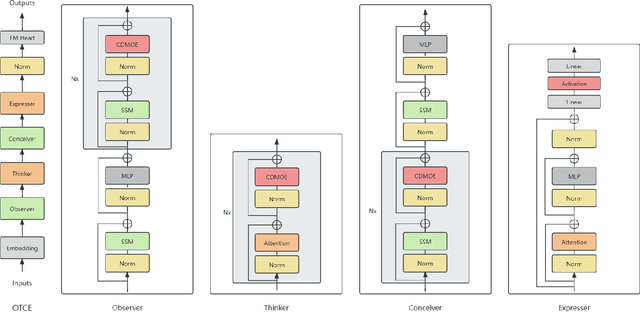Bingheng Wu
Wonderful Matrices: Combining for a More Efficient and Effective Foundation Model Architecture
Dec 16, 2024Abstract:In order to make the foundation model more efficient and effective, our idea is combining sequence transformation and state transformation. First, we prove the availability of rotary position embedding in the state space duality algorithm, which reduces the perplexity of the hybrid quadratic causal self-attention and state space duality by more than 4%, to ensure that the combining sequence transformation unifies position encoding. Second, we propose dynamic mask attention, which maintains 100% accuracy in the more challenging multi-query associative recall task, improving by more than 150% compared to quadratic causal self-attention and state space duality, to ensure that the combining sequence transformation selectively filters relevant information. Third, we design cross domain mixture of experts, which makes the computational speed of expert retrieval with more than 1024 experts 8 to 10 times faster than the mixture of experts, to ensure that the combining state transformation quickly retrieval mixture. Finally, we summarize these matrix algorithms that can form the foundation model: Wonderful Matrices, which can be a competitor to popular model architectures.
Cheems: Wonderful Matrices More Efficient and More Effective Architecture
Jul 25, 2024



Abstract:Recent studies have shown that, relative position encoding performs well in selective state space model scanning algorithms, and the architecture that balances SSM and Attention enhances the efficiency and effectiveness of the algorithm, while the sparse activation of the mixture of experts reduces the training cost. I studied the effectiveness of using different position encodings in structured state space dual algorithms, and the more effective SSD-Attn internal and external function mixing method, and designed a more efficient cross domain mixture of experts. I found that the same matrix is very wonderful in different algorithms, which allows us to establish a new hybrid sparse architecture: Cheems. Compared with other hybrid architectures, it is more efficient and more effective in language modeling tasks.
OTCE: Hybrid SSM and Attention with Cross Domain Mixture of Experts to construct Observer-Thinker-Conceiver-Expresser
Jun 25, 2024



Abstract:Recent research has shown that combining Mamba with Transformer architecture, which has selective state space and quadratic self-attention mechanism, outperforms using Mamba or Transformer architecture alone in language modeling tasks. The quadratic self-attention mechanism effectively alleviates the shortcomings of selective state space in handling long-term dependencies of any element in the sequence. We propose a position information injection method that connects the selective state space model with the quadratic attention, and integrates these two architectures with hybrid experts with cross-sharing domains, so that we can enjoy the advantages of both. We design a new architecture with a more biomimetic idea: Observer-Thinker-Conceiver-Expresser (OTCE), which can compete with well-known medium-scale open-source language models on a small scale in language modeling tasks.
 Add to Chrome
Add to Chrome Add to Firefox
Add to Firefox Add to Edge
Add to Edge